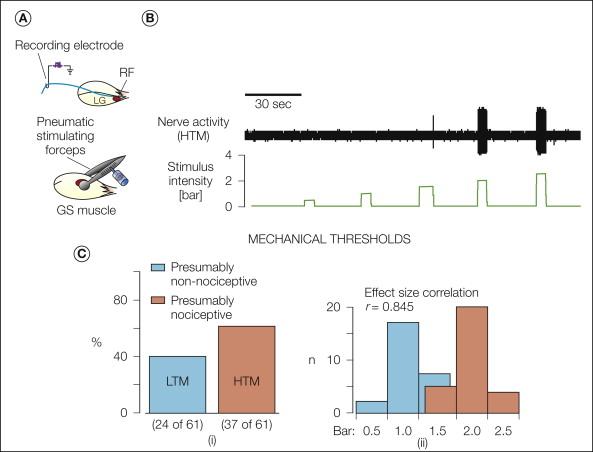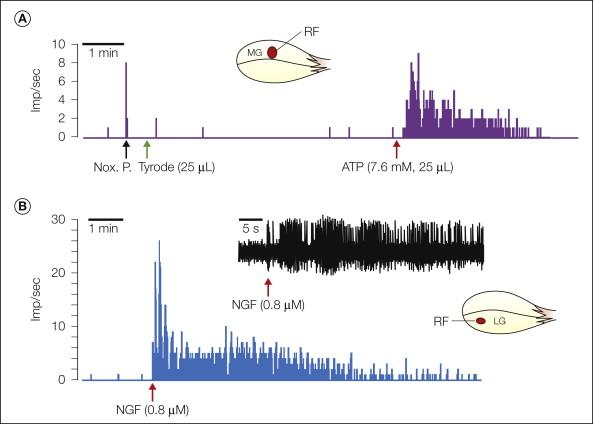Physical Address
304 North Cardinal St.
Dorchester Center, MA 02124
Muscle pain is distinct from cutaneous pain and one of the most common pain complaints. Muscle nociceptors are free nerve endings that are connected to the central nervous system through thin myelinated or unmyelinated afferent fibers. Most nociceptors have no ongoing activity, possess a high mechanical threshold, and can be excited by algesic agents, including bradykinin, serotonin, adenosine triphosphate, protons, and nerve growth factor. In damaged muscle, the nociceptors are sensitized, acquire resting activity, and have a lowered mechanical threshold.
A considerable proportion of free nerve endings also have a low mechanical threshold in intact muscle. They likewise respond to most of the algesic agents. These putative mechanoreceptors probably mediate pressure sensations from muscle or function as “ergoreceptors”; that is, they are involved in the adjustment of circulation and respiration during muscle work.
Afferent fibers from muscle nociceptors have synaptic contact with dorsal horn neurons in the spinal cord or the spinal trigeminal nucleus in the brain stem. Most dorsal horn neurons responding to muscle nociceptors exhibit convergent input from nociceptive as well as non-nociceptive fibers from other tissues such as joints and skin. A muscle lesion induces sensitization of central nociceptive neurons. For central sensitization, low-frequency activation or even subthreshold synaptic potentials are sufficient. Sensitization leads to increased responsiveness, enhanced input convergence, and unmasking of formerly ineffective synapses. The latter mechanism is the basis of referral of muscle pain to sites remote from the damaged muscle. Glial cells are essential for central sensitization and contribute to the transition from acute to chronic muscle pain.
Muscle pain is one of the most common pain complaints: up to 40% of the population in the working age group report musculoskeletal pain ( ). Muscle pain is distinct from cutaneous pain in many respects. Some characteristics of muscle pain—as opposed to skin pain—are listed in Box 45-1 .
No flexor reflexes when the muscle is painfully stimulated
Autonomic symptoms such as a drop in blood pressure, sweating
Convergent input from muscle and other sources to central neurons
Supraspinal processing in centers different from those for cutaneous pain
No first and second pain on sudden stimulation
Difficult to localize
Cramping, aching, tearing nature
Pain referral
Strong affective component
Nausea
Histologically, muscle nociceptors are free nerve endings; that is, with a light microscope, no (corpuscular) receptive structure can be recognized ( ). The endings look like a string of beads, with the beads (axonal expansions) being connected by thin stretches of axon ( ). The afferent fiber of a free nerve ending is either thinly myelinated (group III) or non-myelinated (group IV). The conduction velocity of group IV fibers is 0.4–2.5 m/sec in the cat, and that of group III fibers is 2.5–30 m/sec. Roman numerals (groups I–IV; ) are generally used for fibers from deep somatic tissue (muscle, fascia, joint).
In a recent study, about 60% of the group IV muscle receptors did not respond to innocuous muscle stretch, physiological contractions, and weak pressure stimuli but required noxious (tissue-threatening) pressure for activation ( ; Fig. 45-1 ). Moreover, their discharge rate encoded stimulus strengths within the noxious range. They thus fulfilled the major requirements for a nociceptor. Often, muscle nociceptors exhibiting these response properties are called high-threshold mechanosensitive (HTM) receptors. In group III muscle receptors, the proportion of HTM endings is smaller than that in group IV units. The membrane of HTM receptors may be equipped with as yet unidentified receptors, possibly transient receptor potential (TRP) channels, that have a high mechanical threshold ( ; for a review see ).

Approximately 40% of the group IV units had a low mechanical threshold and responded to everyday stimuli such as weak deformation of muscle tissue ( Fig. 45-1 C). These low-threshold mechanosensitive (LTM) units probably mediate innocuous pressure sensations from muscle (i.e., they are mechanoreceptors; ; ). Another possible function of LTM receptors is that of “ergoreceptors”; that is, they help adjust respiration and circulation during muscular exercise ( ).
Most muscle receptors with group IV and III afferent fibers respond to both mechanical stimuli and algesic agents. The substances in the following sections are effective stimulants for muscle receptors, most of which are released together in damaged muscle ( ).
Adenosine triphosphate (ATP) is released from damaged muscle cells; the normal intracellular ATP concentration is sufficiently high to excite nociceptors in rat gastrocnemius-soleus (GS) muscle ( , ; Fig. 45-2 ). When injected intramuscularly in humans, ATP caused pain ( ). ATP binds to the purinergic membrane receptor P2X 3 .

Many pathological disorders of muscle are associated with a drop in tissue pH. In animal experiments, muscle nociceptors reacted in a graded way to acid solutions, with the lowest pH eliciting the largest responses. Besides acid-sensing ion channels (e.g., ASIC1 and ASIC3), the vanilloid receptor TRPV1 is proton sensitive. The specific ligand of the TRPV1 receptor is capsaicin, and intramuscular injection of capsaicin in humans elicited pain, thus demonstrating the presence of TRPV1 receptors in human muscle ( ).
Inflammatory substances such as bradykinin (BKN), serotonin (5-hydroxytryptamine [5-HT]), and prostaglandin E 2 (PGE 2 ) have long been known to sensitize and excite muscle group IV receptors ( , ). Receptor molecules for BKN are the B 1 and B 2 receptors; for 5-HT, the 5-HT 3 and 5-HT 6 receptors; and for PGE 2 , the prostanoid (EP2) receptor.
The mechanism or mechanisms by which hypertonic saline (5 or 6%) excites muscle receptors are obscure ( ). Possible mechanisms are high extracellular Na + concentrations non-specifically depolarizing the ending, opening a voltage-gated osmoreceptor akin to the one described in the brain (Na v X; ), or exciting the receptors indirectly through glutamate released by Na + ( ).
ATP, protons, capsaicin, and hypertonic saline excite both HTM and LTM endings and are therefore not specific stimulants for nociceptors.
Become a Clinical Tree membership for Full access and enjoy Unlimited articles
If you are a member. Log in here